Solid deliveries in September. Boeing reports strong order haul.
by J. Kasper Oestergaard, European Correspondent, Forecast International.

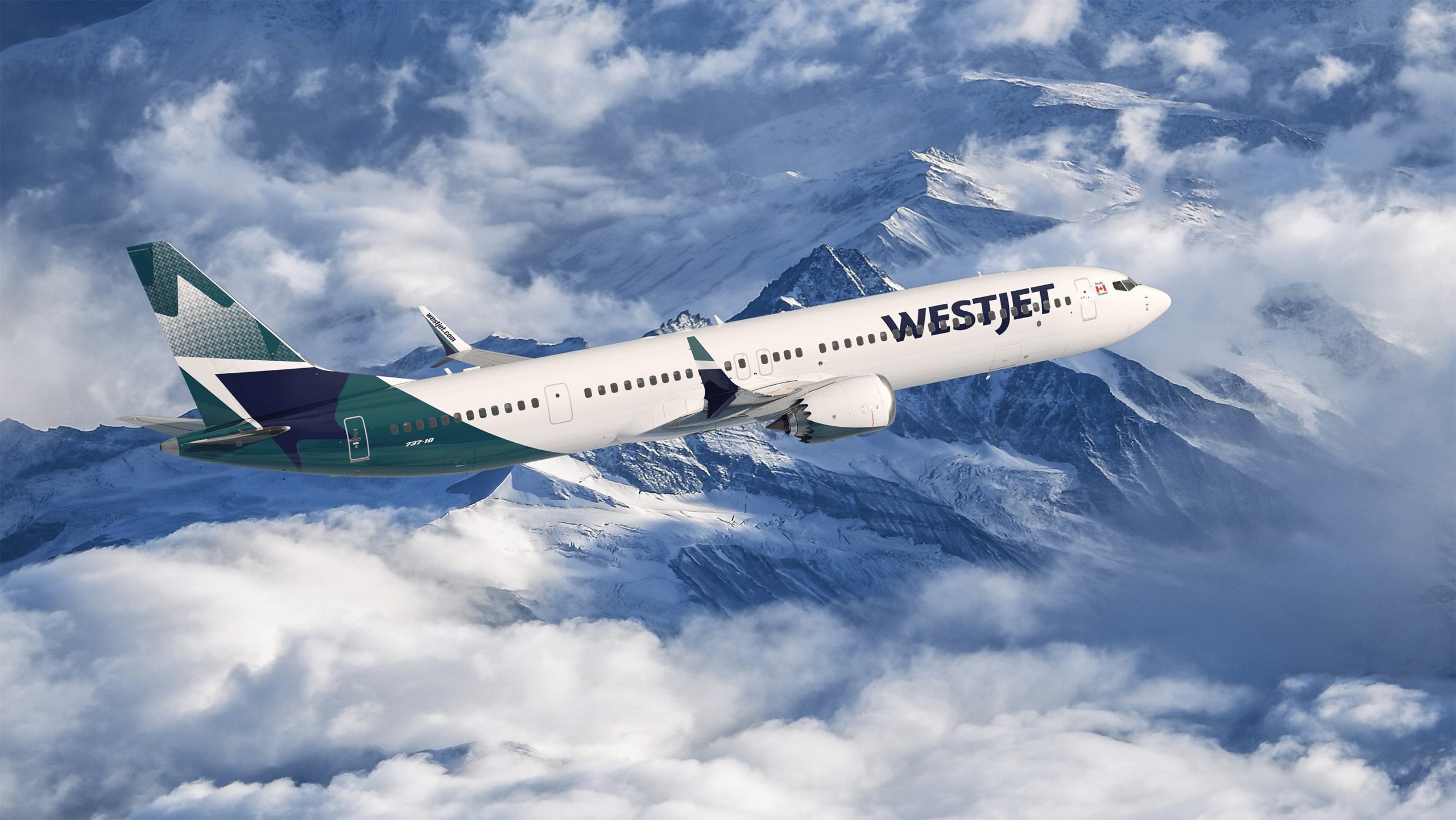
Boeing and Airbus delivered 51 and 53 commercial jets in September 2022, compared to 35 and 40 deliveries, respectively, in the same month last year. Year to date, Boeing and Airbus have delivered 328 and 435 aircraft, compared to 241 and 424, respectively, in the first nine months of 2021. So far this year, Boeing and Airbus are 77 and 11 deliveries ahead of last year’s totals, respectively.
Following a more than challenging 2020 due to the COVID-19 pandemic, 2021 was a year of recovery for the two largest commercial plane makers. With three months of the year remaining, 2022 is set to be another year of recovery for the commercial aircraft manufacturing industry, despite supply chain challenges, macro-economic weakness, and events currently unfolding in Ukraine. Boeing and Airbus still have a long way to go before deliveries are back to pre-pandemic levels, though.
For the full year 2021, Boeing delivered 340 aircraft, compared to 157 in 2020 and 380 in 2019. Boeing’s last “normal” year was 2018 – before COVID-19 and the 737 MAX grounding – when it delivered 806 jets, a level that will likely not be recaptured before 2025. The past three years have been extremely challenging for Boeing but, despite Dreamliner quality issues and 777X delays, the outlook is mostly bright. Dreamliner deliveries have resumed and the 737 MAX is approved to fly in nearly every country. The aircraft, however, has not yet returned to commercial service in China despite the fact that the Civil Aviation Administration of China (CAAC) ungrounded the 737 MAX in December of last year. Recently, it was announced that Boeing will begin to remarket some 737 MAX jets earmarked for Chinese customers. Ongoing political tensions between the United States and China are impeding deliveries, and Boeing is facing perhaps its most difficult situation since entering the Chinese market half a century ago. Chinese airlines are no longer ordering its jets and hundreds of new aircraft cannot be delivered to Chinese customers. On top of that, Boeing is stuck with a completions and delivery center in Zhoushan that it has no need for until the political situation improves. The Zhoushan plant was scaled to accommodate 100 aircraft annually.
In 2021, Airbus delivered 611 aircraft and won the deliveries crown for the third year in a row. Deliveries were up from 566 in 2020 but remain well below the company’s all-time record high of 863 shipments in 2019. Airbus is expected to retain the deliveries lead for the foreseeable future due to the company’s comfortable backlog lead over its American rival. Prior to 2019, Boeing had out-delivered Airbus every year since 2012.
As indicated above, in September 2022, Boeing delivered 51 jets, including 37 737s (36 MAX / 1 NG), five 767s, two 777s, and seven 787s. Since June of this year, the 737 program has been producing aircraft at an official rate of 31 per month, up from 27. The rate of 27 per month was maintained between November 2021 and May 2022 and, prior to that, the monthly rate was just 19. Despite the recent 737 rate increase, ongoing supply chain issues are likely to persist for the time being. Boeing had been considering a boost in 737 production to 38 jets per month in the first half of 2023, followed by another increase to 47 jets per month by the end of 2023, but these plans have now been postponed. In connection with the release of Boeing’s second quarter 2022 earnings, President and CEO David Calhoun commented, “But I do believe we’re at a state now where at 31, we are comfortable the industry can get there and maybe has already gotten there, and then we are going to watch as they qualify more capacity going forward before we pull those rates up.” At present, Boeing’s main supply chain headache is its engine supply.
On August 10, deliveries of the Boeing 787 Dreamliner were resumed following a suspension of shipments that lasted nearly 16 months. The aircraft was delivered to American Airlines, which received its first Dreamliner since April 2021. Boeing suspended Dreamliner deliveries in May 2021 for the second time in less than a year. The current 787 production rate is two aircraft per month, and Boeing expects to continue at this rate for now but will likely return to five per month over time. In March of this year, it was reported that the company was testing the ability of suppliers to meet output scenarios as high as seven per month by the end of 2023. The U.S. Federal Aviation Administration (FAA) has stated that it will inspect each aircraft before issuing airworthiness certificates.
The 777 program was expected to get a new addition in late 2023 with the first delivery of the 777X, but in April Boeing announced this will now not happen before 2025. This reflects an updated assessment of the time required to meet certification requirements. According to Boeing, the 777-9 production rate ramp-up is being adjusted to minimize inventory and the number of planes requiring “change incorporation,” including a temporary pause through 2023. However, Boeing is taking advantage of the adjustment to the 777-9 production schedule by adding 777 freighter capacity starting in late 2023. In January of this year, Boeing launched a new 777X-based freighter, thereby expanding its 777X and cargo portfolio. Qatar Airways will be the 777-8F launch customer.
In September 2022, Airbus delivered 53 jets, including four A220s, 42 A320s (all NEO), five A330s, and two A350s. During 2021, Airbus steadily increased A320 production from 40 per month to 43 in Q3 2021 before finishing the year at a rate of 45 per month. Production will continue to be increased until reaching a monthly rate of 65 by early 2024 (recently pushed back from mid-2023 due to supply chain challenges). Also, Airbus is working with its supply chain to increase the A320 production rate to 75 aircraft per month in 2025. The newest A320NEO family addition, the A321XLR, successfully accomplished its first flight on June 15, 2022. Entry into service, initially planned for the end of 2023, is now expected to take place in early 2024.
The A220, meanwhile, is being produced at a rate of six aircraft per month, up from five at the beginning of the year – with a monthly production rate of 14 envisioned by the middle of the decade. The A350 production rate currently averages five per month and was expected to be increased to six by early 2023. However, the rate increase will likely be delayed until the end of 2023 due to sanctions on Russia and a legal fight between Airbus and Qatar Airways over A350 paint/surface issues. Airbus is currently producing two A330s per month, a rate that is expected to be increased to nearly three aircraft by the end of 2022.
In 2021, Airbus launched the A350 freighter, or A350F, which is a major and much-needed boost to the company’s competitiveness in the cargo segment. Boeing has long dominated the cargo space with its 737-800BCF, 767-300BCF, 767-300F, 777F, 777-8F and 747-8F offerings. Until now, Airbus has only offered the A330-200F, which has not performed well in competition against Boeing’s popular 767-300F. With the launch of the A350F, it appears Airbus is getting serious about capturing more of the cargo aircraft market. The A350F, which carries up to 120 tons (109 metric tons) of cargo, received its first order in November of last year and will predominantly compete with the 777F and later the 777X freighter. In comparison, the 777F has a cargo capacity of up to 112 tons (102 metric tons). To date, the A350F has accumulated 31 net new orders.
Turning to the September orders review, Boeing had a strong month and booked orders from seven customers for a total of 96 jets. However, the company also reported six cancellations (five 737 MAX and one 787), resulting in 90 net new orders. The largest order, for 42 737-10s, was placed by Canadian airline WestJet, followed by Taiwan-based China Airlines, which booked 16 787-9s. Also in September, the U.S. Air Force placed an order for 15 KC-46 tankers (based on the 767-2C). Also, an undisclosed customer ordered 12 777X widebody jets. Other customers ordered a total of nine 737 MAXs and two 777Fs. Year to date, Boeing has accumulated 428 net new orders (542 gross orders). In 2021, Boeing booked 909 gross orders and received 430 cancellations, for a total of 479 net new orders (before ASC 606 changes). Please note that for comparison reasons, we do not include Boeing’s so-called ASC 606 accounting adjustments in the numbers reported in this article and regard net new orders as gross orders minus cancellations.
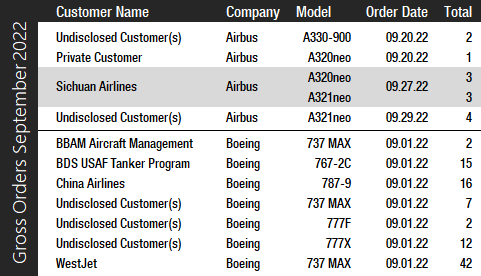
In September, Airbus booked 13 orders from four different customers and reported three cancellations (two A319 NEOs and one A220-300). Chengdu-based Sichuan Airlines ordered three A320neos and three A321neos. Other customers ordered four A321neos, two A330-900s and one A320neo. Year to date, Airbus has accumulated 647 net new orders (856 gross orders), surpassing both 2021 gross orders and net new orders. In 2021, Airbus booked a total of 771 gross orders and received 264 cancellations, for a total of 507 net new orders – enough to win the orders crown for the third year in a row. It should be noted, however, that if Boeing’s 2021 ASC 606 adjustments were included, Boeing would have come out ahead with 535 net new orders.
At the end of September 2022, Airbus reported a backlog of 7,294 jets, of which 6,661, or 91 percent, were A220 and A320ceo/neo family narrowbodies. This is 431 aircraft below the company’s all-time backlog record of 7,725 aircraft set in January 2020. By the end of September, Boeing’s backlog (total unfilled orders before ASC 606 adjustment) was 5,236 aircraft, of which 4,194, or 80 percent, were 737 NG/MAX narrowbody jets. Boeing’s all-time backlog high of 5,964 aircraft was set in August 2018. The number of Airbus aircraft to be built and delivered represents 8.5 years of shipments at the 2019 production level (the pre-pandemic level), or 11.9 years based on the 2021 total. In comparison, Boeing’s backlog would “only” last 6.5 years at the 2018 level (the most recent “normal” year for Boeing), or 15.4 years based on 2021 deliveries. In 2022 to date, Boeing’s book-to-bill ratio, calculated as net new orders divided by deliveries, is 1.30. Airbus’ book-to-bill ratio is 1.49. In 2021, Boeing’s book-to-bill ratio was 1.41, while Airbus reported a book-to-bill of 0.81.
2022 Forecast
Forecast International’s Platinum Forecast System is a breakthrough in forecasting technology that provides 15-year production forecasts. The author has used the Platinum Forecast System to retrieve the latest delivery forecast data from the Civil Aircraft Forecast product. For 2022, Forecast International’s analysts currently expect Boeing and Airbus to deliver 448 and 668 commercial jets, respectively. Compared to the 2021 level, this is a 31.8 percent increase for Boeing and a 9.3 percent increase for Airbus.
Boeing released second quarter 2022 results on July 27 and expects to finish the year with 737 MAX deliveries in the low 400s. Airbus released Q2 2022 earnings on July 27 and lowered its 2022 guidance from 720 deliveries to 700. As the basis for its 2022 guidance, the company assumes no further disruptions to the world economy, air traffic, and its own internal operations. Boeing will report Q3 2022 earnings on October 26, followed by Airbus’ earnings release two days later.
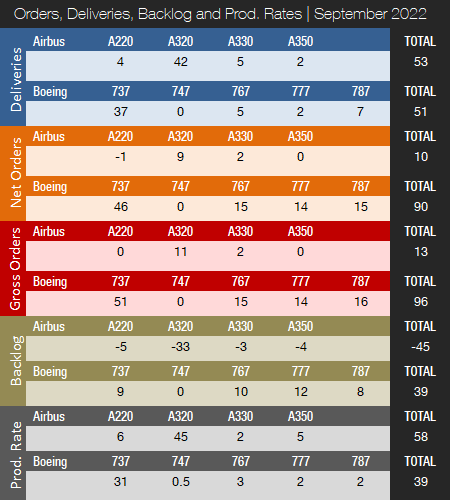
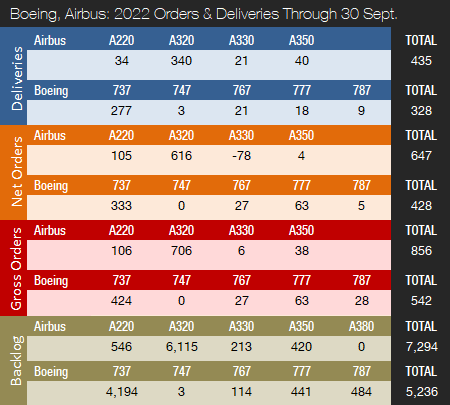
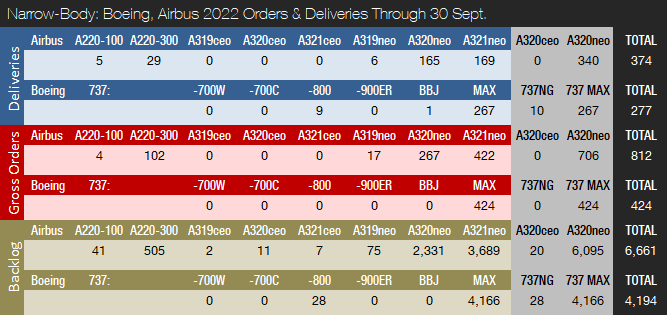
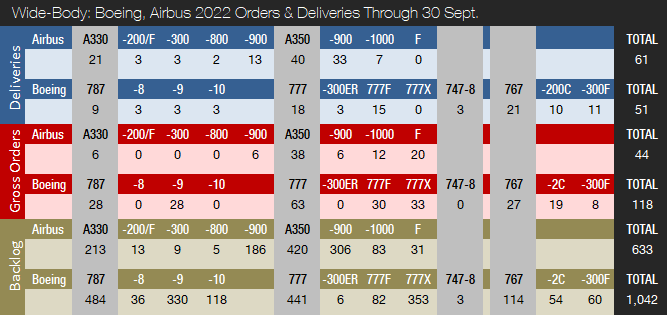
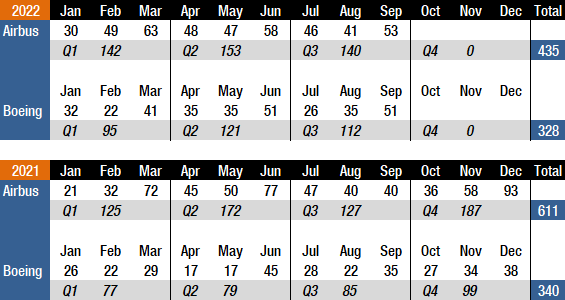
References:
- https://www.forecastinternational.com/platinum.cfm
- http://www.boeing.com/commercial/#/orders-deliveries
- https://www.airbus.com/aircraft/market/orders-deliveries.html
- https://www.airbus.com/en/newsroom/press-releases/2022-07-airbus-reports-half-year-h1-2022-results
- https://boeing.mediaroom.com/2022-07-27-Boeing-Reports-Second-Quarter-Results
- https://www.reuters.com/business/aerospace-defense/boeing-makes-first-787-dreamliner-delivery-since-may-2021-2022-08-10/
- https://www.reuters.com/business/aerospace-defense/boeing-plans-remarket-some-737-max-jets-earmarked-chinese-airlines-2022-09-15/
- https://simpleflying.com/boeing-737-max-china-deliveries-ready/
- https://boeing.mediaroom.com/2022-09-29-WestJet-Expands-Fleet-with-Largest-Boeing-737-MAX-Jet,-Ordering-Up-to-64-Fuel-efficient-Airplanes#assets_20295_131144-117
- https://boeing.mediaroom.com/2022-09-28-China-Airlines-Finalizes-Landmark-Order-for-Up-to-24-Boeing-787-Dreamliners
- https://boeing.mediaroom.com/2022-10-11-Boeing-Announces-Third-Quarter-Deliveries
Forecast International’s Civil Aircraft Forecast covers the rivalry between Airbus and Boeing in the large airliner sector; the emergence of new players in the regional aircraft segment looking to compete with Bombardier, Embraer, and ATR; and the shifting dynamics within the business jet market as aircraft such as the Bombardier Global 7000, Cessna Hemisphere, and Gulfstream G600 enter service. Also detailed in this service are the various market factors propelling the general aviation/utility segment as Textron Aviation, Cirrus, Diamond, Piper, and a host of others battle for sales and market share. An annual subscription includes 75 individual reports, most with a 10-year unit production forecast. Click here to learn more.
Kasper Oestergaard is an expert in aerospace & defense market intelligence, fuel efficiency in civil aviation, defense spending and defense programs. Mr. Oestergaard has a Master's Degree in Finance and International Business from the Aarhus School of Business - Aarhus University in Denmark. He has written four aerospace & defense market intelligence books as well as numerous articles and white papers about European aerospace & defense topics.



